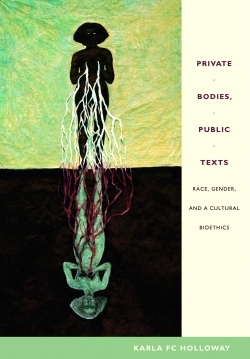Private Bodies, Public Texts
Race, Gender, and a Cultural Bioethics
“Human females are not as easy to investigate as are rabbits,” complained Katherine McCormick, the philanthropist who funded the development of the contraceptive pill. She asked for a “cage of ovulating females to experiment with” and the scientists she supported found the “the perfect laboratory” in Puerto Rico, where they conducted a trial of the pill among women in a housing project.
Another public housing project, in Montgomery, Alabama, was the site of birth control efforts that Karla FC Holloway, a professor of English at Duke University, describes in Private Bodies, Public Texts. In 1971, shortly after Lonnie and Minnie Relf moved into an apartment with their three daughters, aged fourteen, twelve, and ten, they were visited by welfare workers. Concerned that the girls would soon be at risk for unprotected sex and noting that “boys were hanging around,” the workers recommended contraception. Two years later, the younger daughters were taken to a hospital and sterilized.
Holloway wonders if it is “the potential of women to bear children that renders their bodies immediately and irretrievably public and available.” Poor blacks such as the Relfs, dependent on government assistance for medical care, are especially likely to suffer loss of privacy and to cede control over their bodies to paternalistic workers.
Sexual relations and their consequences, Holloway says, “seem to make the most riveting public narratives.” In a rural area in central India, where vaginal discharge is considered a sign of promiscuity and women rarely discuss it with health workers, researchers tried to estimate the extent of the problem through group discussions and individual interviews with hundreds of women. A traditional birth attendant revealed her own rough and ready measurement technique: she went around the village looking at the laundry the women put out to dry; stains on the clothes told her who had discharge. As early as 1890, in their essay, “The Right to Privacy,” published in the Harvard Law Review, Samuel Warren and Louis Brandeis wrote that a person’s dwelling may be an impregnable castle in law, but in reality the back door is often open to “prurient curiosity;” they worried that “what is whispered in the closet shall be proclaimed from the house-tops.”
That researchers sometimes place the health and privacy of their subjects low on their list of priorities is not surprising. Some research endeavors, however, breach rules of morality so often and so clearly that they become “landmark examples” of human abuse. The Tuskegee study, in which hundreds of men with syphilis were not offered treatment for decades after a cure became available, is well known. Holloway relates other cases, including the surgical operations conducted by James Marion Sims, a nineteenth-century American physician. Over a four-year period, Sims saw several women who complained of “leakage of urine following a protracted labor,” a condition that had no treatment at the time, and was described by Johann Friedrich Dieffenbach, a German surgeon, as producing a “most intolerable stench.” Sims devised an instrument for examining vaginas that allowed him to see “everything, as no man had ever seen before” and perfected a surgical procedure to stop the leakage after testing it on slave women. He operated on the women repeatedly, without administering anesthesia, and invited other physicians to watch; Anarcha, “a young colored woman, who had never murmured at the preceding failures” was cured after the thirtieth operation.
Medical and legal narratives are often reduced to essentials; lacking social, political, and historical detail, such cases fail to provide the context that ethicists need as they deal with moral quandaries. In her exceptional book, Holloway turns to literature to “illustrate matters of ethical concern and to assist listeners in hearing a patient’s story, in order to develop a more thoughtful perspective on treatment.” Alongside moving passages from Margaret Edson’s play Wit, Kazuo Ishiguro’s novel Never Let Me Go, Octavia Butler’s short story Bloodchild, Jodi Picoult’s novel My Sister’s Keeper, and other texts, Holloway offers incisive comments that relate fictional episodes to real-life events, enhancing the ability of both to reveal the deep connections that bind ethics to culture, race, and gender.
Private Bodies, Public Texts invites health professionals, lawyers and ethicists to honor those connections.
Reviewed by
Karunesh Tuli
Disclosure: This article is not an endorsement, but a review. The publisher of this book provided free copies of the book to have their book reviewed by a professional reviewer. No fee was paid by the publisher for this review. Foreword Reviews only recommends books that we love. Foreword Magazine, Inc. is disclosing this in accordance with the Federal Trade Commission’s 16 CFR, Part 255.

